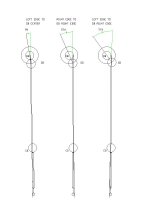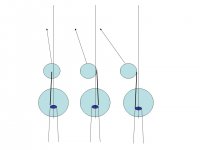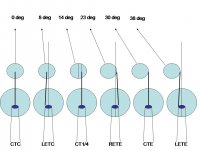This is an adaptation of Shane's one example.
Any thoughts?:thumbup:
Shane aiming the side of the ferrule at the edge of the OB for a moderately thin cut shot.
Watch at 7:53 where Shane describes how he aims the side of the shaft/ferrule to the side of the OB on a cut shot.
http://www.youtube.com/watch?v=D3o1zKWQGWc
Expanding on that one example
I watched Shane’s example of aiming the edge of the ferrule at the outside edge of the OB and my take away, to expand on that one shot, are as follows:
I am sure that he aims the center of the CB to the center of the OB for a straight in shot, and that he aims the center of the CB to the edge about the equator (3:00 and 9:00) of the OB for the 30 degree cut.
Using the side of the cue shaft to aim for cuts greater than ~30 degrees will yield a predictable cut angle depending on the size of the ferrule. The difference between a 13mm and 11mm diameter ferrule are within 1 degree.
The fact that the edge (9:00 and 3:00) of the OB is used and is very observable is a plus...rather than a vague GB center.
If the cut is very thin say ~75 degrees, then the side of the shaft must be aimed a small distance outward from the edge of the OB.
This is useful info on how to achieve and vary the cut angle from the line of centers which my Acad geometric diagrams document diagrammed below.
Aim the sides of the ferrule to the center and to the right edge of the OB for cuts to the left. The right edge of the ferrule can be aimed at the right edge of the OB as can the left edge of the ferrule.
Reverse for cuts to the right.
Cut angles not diagrammed
For a 15 degree cut (not diagramed), aim the center of the shaft/ferrule at the ¾ spot between the center of the OB and it’s tight edge.
Most know that a straight in shot is the center of the CB to the center of the OB.
Also, the 30 degree cut angle is the center of the CB aimed at the right edge of the OB (3:00).
Since the side of the ferrule aiming gives one a 7-8 degree angle to either side respectively to the outside of the center of the ferrule aim.
That covers 7, 15, 23, 30 and 38 degree cut angles…one can aim a bit less than the side of the ferrule for angles in between or use outside english.
In order to achieve these geometric angles, one needs to apply a bit of outside english to effect gearing an prevent skidding that is effected by a center CB hit.
Changing the cut angle with outside english.
The amount of outside english will allow one to increase or decrease the cut angle up to +/- 4 degrees.
I measured the included angle between the line of centers (geometric angle) with slight outside english to no english for CTE and the included angle was 4 degrees less than the line of centers.
I then measured the included angle between the line of centers with extreme outside english for SIT and the included angle was also about 4 degrees greater than the line of centers.
Inside english
Aiming the edge of the ferrule at the outside edge of the OB and applying inside english yields approximately a 45 degree cut angle, but this will vary with the amount of english and speed.
Using parts of the ferrule for slightly different angles.
One can also use fractions of the ferrule from its center to its edge to alter the geometric line of centers (below) i.e., 1/8 or ¼ inside of the edge of the diameter of the ferrule etc..

Any thoughts?:thumbup:
Shane aiming the side of the ferrule at the edge of the OB for a moderately thin cut shot.
Watch at 7:53 where Shane describes how he aims the side of the shaft/ferrule to the side of the OB on a cut shot.
http://www.youtube.com/watch?v=D3o1zKWQGWc
Expanding on that one example
I watched Shane’s example of aiming the edge of the ferrule at the outside edge of the OB and my take away, to expand on that one shot, are as follows:
I am sure that he aims the center of the CB to the center of the OB for a straight in shot, and that he aims the center of the CB to the edge about the equator (3:00 and 9:00) of the OB for the 30 degree cut.
Using the side of the cue shaft to aim for cuts greater than ~30 degrees will yield a predictable cut angle depending on the size of the ferrule. The difference between a 13mm and 11mm diameter ferrule are within 1 degree.
The fact that the edge (9:00 and 3:00) of the OB is used and is very observable is a plus...rather than a vague GB center.
If the cut is very thin say ~75 degrees, then the side of the shaft must be aimed a small distance outward from the edge of the OB.
This is useful info on how to achieve and vary the cut angle from the line of centers which my Acad geometric diagrams document diagrammed below.
Aim the sides of the ferrule to the center and to the right edge of the OB for cuts to the left. The right edge of the ferrule can be aimed at the right edge of the OB as can the left edge of the ferrule.
Reverse for cuts to the right.
Cut angles not diagrammed
For a 15 degree cut (not diagramed), aim the center of the shaft/ferrule at the ¾ spot between the center of the OB and it’s tight edge.
Most know that a straight in shot is the center of the CB to the center of the OB.
Also, the 30 degree cut angle is the center of the CB aimed at the right edge of the OB (3:00).
Since the side of the ferrule aiming gives one a 7-8 degree angle to either side respectively to the outside of the center of the ferrule aim.
That covers 7, 15, 23, 30 and 38 degree cut angles…one can aim a bit less than the side of the ferrule for angles in between or use outside english.
In order to achieve these geometric angles, one needs to apply a bit of outside english to effect gearing an prevent skidding that is effected by a center CB hit.
Changing the cut angle with outside english.
The amount of outside english will allow one to increase or decrease the cut angle up to +/- 4 degrees.
I measured the included angle between the line of centers (geometric angle) with slight outside english to no english for CTE and the included angle was 4 degrees less than the line of centers.
I then measured the included angle between the line of centers with extreme outside english for SIT and the included angle was also about 4 degrees greater than the line of centers.
Inside english
Aiming the edge of the ferrule at the outside edge of the OB and applying inside english yields approximately a 45 degree cut angle, but this will vary with the amount of english and speed.
Using parts of the ferrule for slightly different angles.
One can also use fractions of the ferrule from its center to its edge to alter the geometric line of centers (below) i.e., 1/8 or ¼ inside of the edge of the diameter of the ferrule etc..

Last edited:



